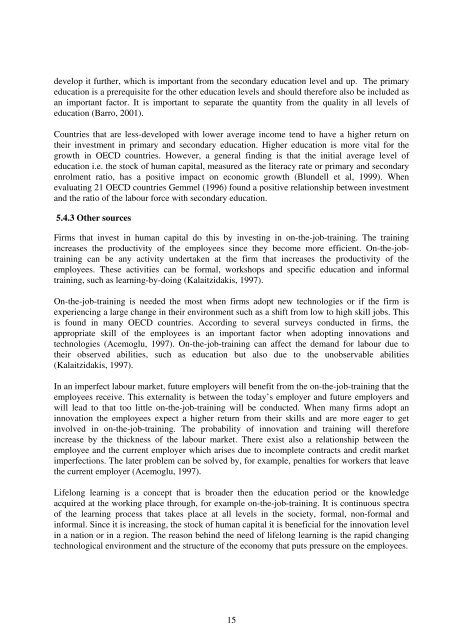INNOVATION POLICY INSTRUMENTS
INNOVATION POLICY INSTRUMENTS
INNOVATION POLICY INSTRUMENTS
You also want an ePaper? Increase the reach of your titles
YUMPU automatically turns print PDFs into web optimized ePapers that Google loves.
develop it further, which is important from the secondary education level and up. The primary<br />
education is a prerequisite for the other education levels and should therefore also be included as<br />
an important factor. It is important to separate the quantity from the quality in all levels of<br />
education (Barro, 2001).<br />
Countries that are less-developed with lower average income tend to have a higher return on<br />
their investment in primary and secondary education. Higher education is more vital for the<br />
growth in OECD countries. However, a general finding is that the initial average level of<br />
education i.e. the stock of human capital, measured as the literacy rate or primary and secondary<br />
enrolment ratio, has a positive impact on economic growth (Blundell et al, 1999). When<br />
evaluating 21 OECD countries Gemmel (1996) found a positive relationship between investment<br />
and the ratio of the labour force with secondary education.<br />
5.4.3 Other sources<br />
Firms that invest in human capital do this by investing in on-the-job-training. The training<br />
increases the productivity of the employees since they become more efficient. On-the-jobtraining<br />
can be any activity undertaken at the firm that increases the productivity of the<br />
employees. These activities can be formal, workshops and specific education and informal<br />
training, such as learning-by-doing (Kalaitzidakis, 1997).<br />
On-the-job-training is needed the most when firms adopt new technologies or if the firm is<br />
experiencing a large change in their environment such as a shift from low to high skill jobs. This<br />
is found in many OECD countries. According to several surveys conducted in firms, the<br />
appropriate skill of the employees is an important factor when adopting innovations and<br />
technologies (Acemoglu, 1997). On-the-job-training can affect the demand for labour due to<br />
their observed abilities, such as education but also due to the unobservable abilities<br />
(Kalaitzidakis, 1997).<br />
In an imperfect labour market, future employers will benefit from the on-the-job-training that the<br />
employees receive. This externality is between the today’s employer and future employers and<br />
will lead to that too little on-the-job-training will be conducted. When many firms adopt an<br />
innovation the employees expect a higher return from their skills and are more eager to get<br />
involved in on-the-job-training. The probability of innovation and training will therefore<br />
increase by the thickness of the labour market. There exist also a relationship between the<br />
employee and the current employer which arises due to incomplete contracts and credit market<br />
imperfections. The later problem can be solved by, for example, penalties for workers that leave<br />
the current employer (Acemoglu, 1997).<br />
Lifelong learning is a concept that is broader then the education period or the knowledge<br />
acquired at the working place through, for example on-the-job-training. It is continuous spectra<br />
of the learning process that takes place at all levels in the society, formal, non-formal and<br />
informal. Since it is increasing, the stock of human capital it is beneficial for the innovation level<br />
in a nation or in a region. The reason behind the need of lifelong learning is the rapid changing<br />
technological environment and the structure of the economy that puts pressure on the employees.<br />
15
















